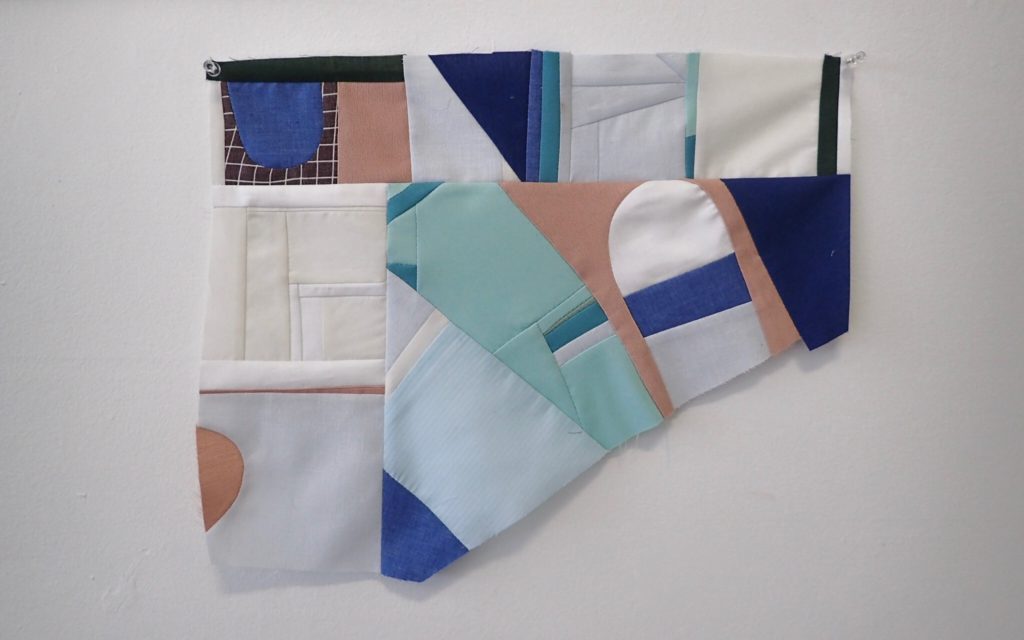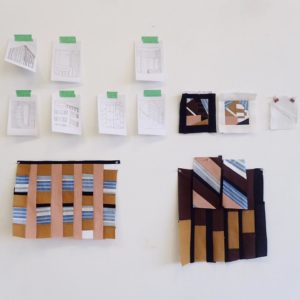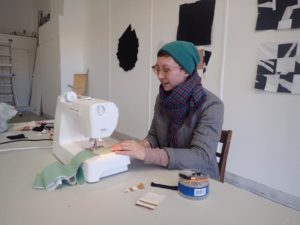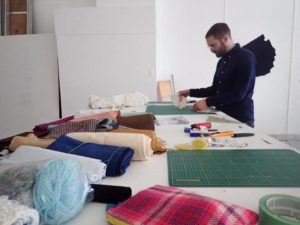Eric Moschopedis and Mia Rushton have been taking the residency at the Neighbourhood Time Exchange | Downtown Prince George as an opportunity to more deeply explore the role of materiality in their shared practice. The duo are award-winning interdisciplinary visual artists, facilitators, and community organizers, whose work invites audiences to become active agents in the creation of community. Throughout their extensive collaborative practice, they have poked into many areas of craft-based production, but for the past month the two artists have been focusing on a series of textile and quilting-based experiments.

Their present studio-based production is part of an ongoing developing trajectory in the artists’ work where the collaborative quality of the project is not only a conceptual framework, but a manifestly physical component of the artwork as well. Several years ago, the artists “began a year of research with the expressed purpose of learning how to translate ephemeral social engagement into static art objects”, which resulted in the durational text-based quilting project, Because even under the cover of darkness we are haunted by the past (2011). In the studio space on Third Avenue in Prince George, Moschopedis and Rushton have picked up on this line of work once again, but their present experimentations seem to be more nuanced towards the role of collaboration in creative practices. The studio is filled with small, intimately detailed patchwork pieces, artworks that visibly display multi-directionality. The complexity of the patterning and the detailing of the stitching creates an intense dynamism despite their small scale. The process involves each artist starting on their own small quilt sample, which they work on independently for a period of time. Then, they switch, and continue the piece where the other artist has left off. In many ways this practice is reminiscent of the Surrealist exquisite corpse game, where several people contribute to a single drawing in a playful and hybrid activity. To add to this parallel with Surrealist strategies, the movement’s doctrine popularized by André Breton, “as beautiful as the chance encounter of a sewing machine and an umbrella on an operating table”, is a phrase that marks a similar attentiveness to the stitching together of seemingly disparate parts.
Collaboration, in its most romanticized form, is designed to be a process whereby many authors appear as one. The interests and objectives of different individuals are fused in such a way that individual priorities are subsumed to the workings of the greater group. It is not so often that the uncouth messiness of collaboration, including the fractures, fissures, and seams between ideas and personalities are highlighted. The artists spoke of both the thrills and challenges of this kind of making. Rushton noted the difficulties of overcoming the preciousness of the things we make by hand, of being able to let go of something you have put effort and care into. Moschopedis expressed the pleasure of being able to rip things apart and cut things up, to reshape and modify a piece dramatically. While referring specifically to the physical act of making these artworks, these sentiments also speak to a broader and deeper understanding of collaborative processes.

There are many versions of what collaboration looks like, and these sewing experiments provide the artists with another entry point into understanding complex relationships. As pieces in process, these works have loose and unfinished edges. For now, these unhemmed sides remain indicators that the work still has room to grow. Moschopedis remarked that a part of their interest in developing tactile works during this residency was because of a desire to think about works that have a lifespan, or lifetime, of their own. The kind of generative animism suggested here is much less clinical than the version proposed on Breton’s operating table, and more in-tune to a kind of growth and development that appears to be sensitively swaddled up in the warmth and comfort of a quilt.


